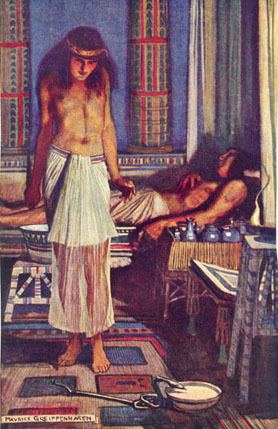 | ||
Similar Tale of the Shipwrecked Sailor, Tale of Two Brothers, Story of Wenamun, Popular Stories of Ancient E, Book of the Heavenly Cow | ||
The tale of the doomed prince
The Tale of the Doomed Prince is an ancient Egyptian story, dating to the 18th Dynasty, written in hieratic text, which survived partially on the verso of Papyrus Harris 500 currently housed in the British Museum. The papyrus was burned in an explosion; because of this damage the conclusion of the story is missing. Some scholars speculate that the missing ending was mostly likely a happy one and that the tale could be more aptly named "The Prince who was Threatened by Three Fates" or the like.
Contents
There are dozens of translations of this story from a wide variety of scholars. The translations by Miriam Lichtheim and William Kelly Simpson from the 1970s are both widely accepted versions.
Synopsis
The story goes as follows: The king of Egypt was very sad that a son had not yet been born to him. The king prays to the gods, and that night his wife conceives a child. When the king's son is born the seven Hathors (goddesses, who pronounce the fate of each child at birth) foretell that he will die either by crocodile, snake or dog. His father, afraid for his son’s safety, builds his son an isolated palace in the mountains, so as to keep him away from danger. The prince sees from his palace, a man with a dog. He asks his father for a dog. The king warily gives the prince a dog, not wishing his son to be unhappy. When the prince grows up, he decides to face his doom, travelling abroad to Nahrin. There he meets a group of young men competing for the heart of the princess. The prince succeeds in winning the heart of a princess by jumping (possibly flying) to the window of the room where the princess is locked up. The prince did not tell the king the truth about himself, but said he was the son of a charioteer, and explained that he had had to leave home because of his new stepmother. Eventually the king agrees to let the prince-in-disguise marry his daughter, after seeing the merits of the young man. After marrying the princess he tells her of his three dooms, and of his prince-hood. She urges him to kill the dog, but the prince cannot bear to kill the dog he has raised from a puppy. His wife watches over him dutifully, and stops a snake from biting the prince in his sleep. Thus, one of the prince’s fates is defeated. Some time after that the prince goes for a walk with his dog. The dog began speaking (the dog possibly bites the prince), and told the prince he was meant to be killed by the dog. Fleeing from the dog, he runs to a lake where he is seized by a crocodile who, instead of killing him, enlists his help in its fight against a demon (or a water spirit)
This is where the tale breaks off.
Significance
This story is an example of an Egyptian folktale. It shows the existence of written and oral traditions in ancient Egyptian culture. The story also emphasizes the importance of the concept of fate to the Egyptian society. The idea of personal fate, destiny or doom surely played an integral role in people’s lives. The tale also highlights the perception of bravery and heroism. The prince performs a feat of daring heroism to rescue and marry the princess. In addition, something can be seen in this story of the relationship between husband and wife. The husband is honest with his wife, and the wife protects her husband. Another important point is the fact that the prince leaves Egypt and goes abroad to seek his fortune. It details aspects of the prince's life once he leaves his homeland.
Motifs
Some of its motifs reappear in later European fairy tales.
